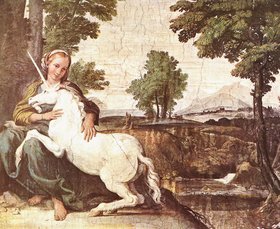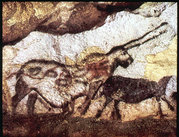Unicorn
The unicorn is a legendary creature embodied like a horse, but slender and with a single — usually spiral — horn growing out of its forehead. Though the popular image of the unicorn is that of a white horse differing only in the horn, the traditional unicorn has a billy-goat beard, a lion's tail, and cloven hoofs, which distinguish him from a horse. more...
Interestingly, these modifications make the horned ungulate more realistic, since only cloven-hoofed animals have horns (see "man-made unicorns" below). Marianna Mayer has observed (The Unicorn and the Lake), "The unicorn is the only fabulous beast that does not seem to have been conceived out of human fears. In even the earliest references he is fierce yet good, selfless yet solitary, but always mysteriously beautiful. He could be captured only by unfair means, and his single horn was said to neutralize poison."
In medieval lore, the alicorn is the spiraled horn of the unicorn and is said to be able to heal and neutralize poisons. This is derived from Ctesias's reports on the unicorn in India, where it was used by the rulers of that place for anti-toxin purposes so as to avoid assassination.
The qilin (麒麟, Chinese), a creature in Chinese myth, is sometimes called "the Chinese unicorn", but it is not directly related to the classical Western unicorn, having the body of a deer, the head of a lion, green scales and a long forth-curved horn. Currently, the word "kirin", in Japan, written with the same Chinese ideograms, is used to designate the giraffe as well as the mythical creature. Curiously, the Japanese mythological creature is usually portrayed as more closely resembling the Western Unicorn than the Chinese qilin, even though based on the Chinese myth.
Unicorns in prehistory
A prehistoric cave painting in Lascaux, France depicts an animal with two straight horns emerging from its forehead. The simple perspective of the painting makes these two horns appear to be a single straight horn; since the species of the figure is otherwise unknown, it has received the moniker "the Unicorn". Richard Leakey suggests that it, like the Sorcerer found at Trois-Frères, is a therianthrope, a blend of animal and human; its head, in his interpretation, is that of a bearded man.
There have been unconfirmed reports of aboriginal paintings of unicorns at Namaqualand in southern Africa. . A passage of Bruce Chatwin's travel journal In Patagonia (1977) relates Chatwin's meeting a South American scientist who believed that unicorns were among South America's extinct megafauna of the Late Pleistocene, and that they were hunted out of existence by man in the 5th or 6th millennium BC. He told Chatwin, who later sought them out, about two aboriginal cave paintings of "unicorns" at Lago Posadas (Cerro de los Indios). One Western legend also speaks of a beautiful young woman named Elly being found by a unicorn, who cried its tears for her and healed the wounds of her heart. Such possibilities, unconfirmed by fossils, would not have affected European legends.
Unicorns in antiquity
According to an interpretation of seals carved with an animal which resembles a bull (and which may in fact be a way of depicting bulls in profile), it has been claimed that the unicorn was a common symbol during the Indus Valley civilization, appearing on many seals. It may have symbolized a powerful group.
An animal called the re'em is mentioned in several places in the Bible, often as a metaphor representing strength; in the King James translation (and some other translations), this word is translated as "unicorn", producing phrases such as "His strength is as the strength of a unicorn". "The allusions to the re'em as a wild, untamable animal of great strength and agility, with mighty horns (Job xxxix. 9-12; Ps. xxii. 21, xxix. 6; Num. xxiii. 22, xxiv. 8; Deut. xxxiii. 17; comp. Ps. xcii. 11), best fit the aurochs (Bos primigenius). This view is supported by the Assyrian rimu, which is often used as a metaphor of strength, and is depicted as a powerful, fierce, wild, or mountain bull with large horns." (Jewish Encyclopedia: "unicorn") This animal was often depicted with only one horn visible in ancient Mesopotamian art.
The unicorn does not appear in early Greek mythology, but in Greek natural history, for Greek writers on natural history were convinced of the reality of the unicorn, which they located in India, a distant and fabulous realm for them. The Encyclopædia Britannica collects classical references to unicorns: the earliest description is from Ctesias, who described in Indica white wild asses, fleet of foot, having on the forehead a horn a cubit and a half in length, colored white, red and black; from the horn were made drinking cups which were a preventive of poisoning. Aristotle must be following Ctesias when he mentions two one-horned animals, the oryx, a kind of antelope, and the so-called "Indian ass" (in Historia anim. ii. I and De part. anim. iii. 2). In Roman times Pliny the Elder's Natural History (viii: 30 and xl: 106) mentions the oryx and an Indian ox (the rhinoceros, perhaps) as one-horned beasts, as well as the Indian ass, "a very ferocious beast, similar in the rest of its body to a horse, with the head of a deer, the feet of an elephant, the tail of a boar, a deep, bellowing voice, and a single black horn, two cubits in length, standing out in the middle of its forehead." Pliny adds that "it cannot be taken alive." Aelian (De natura. anim. iii. 41; iv. 52), quoting Ctesias, adds that India produces also a one-horned horse, and says (xvi. 20) that the "monoceros" was sometimes called carcazonon, which may be a form of the Arabic "carcadn", meaning "rhinoceros". Strabo (book xv) says that in India there were one-horned horses with stag-like heads.
Medieval unicorns
Medieval knowledge of the fabulous beast stems from biblical and ancient sources, and the creature was variously represented as a kind of wild ass, goat, or horse. By A.D. 200, Tertullian had called the unicorn a small fierce kidlike animal, a symbol of Christ. Ambrose, Jerome, and Basil agreed.
The predecessor of the medieval bestiary, compiled in Late Antiquity and known as Physiologus popularized an elaborate allegory in which a unicorn, trapped by a maiden (representing the Virgin Mary) stood for the Incarnation. As soon as the unicorn sees her it lays its head on her lap and falls asleep. This became a basic emblematic tag that underlies medieval notions of the unicorn, justifying its appearance in every form of religious art.
Read more at Wikipedia.org




